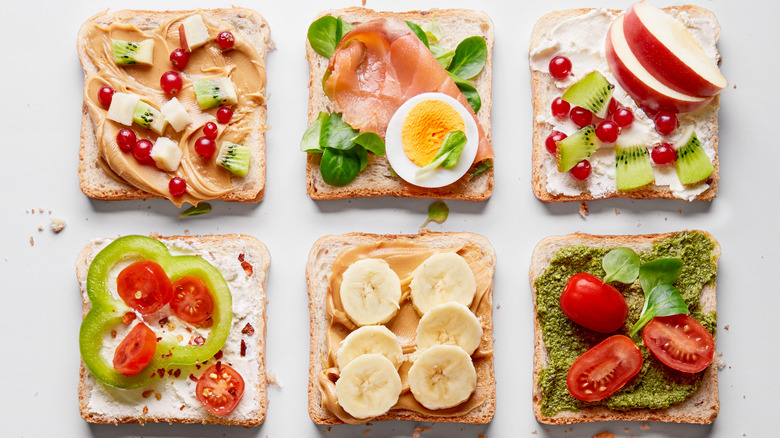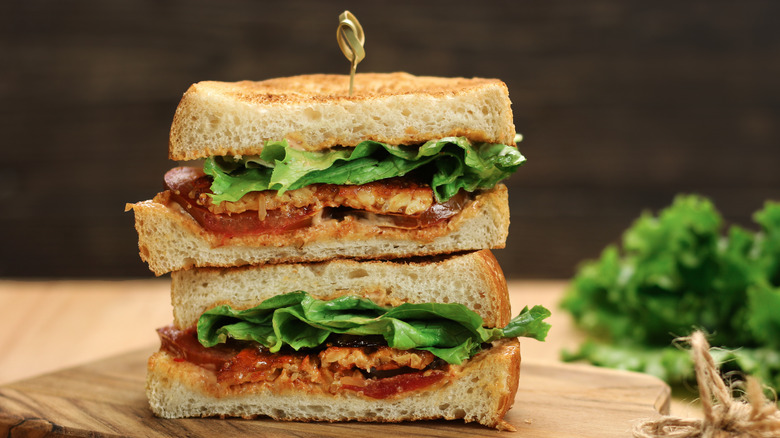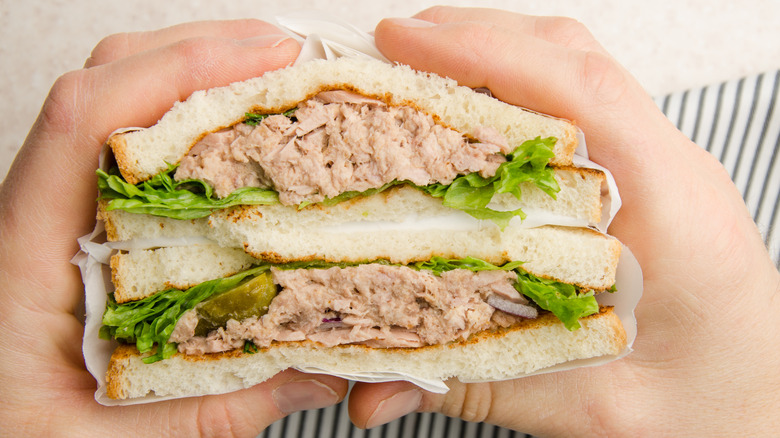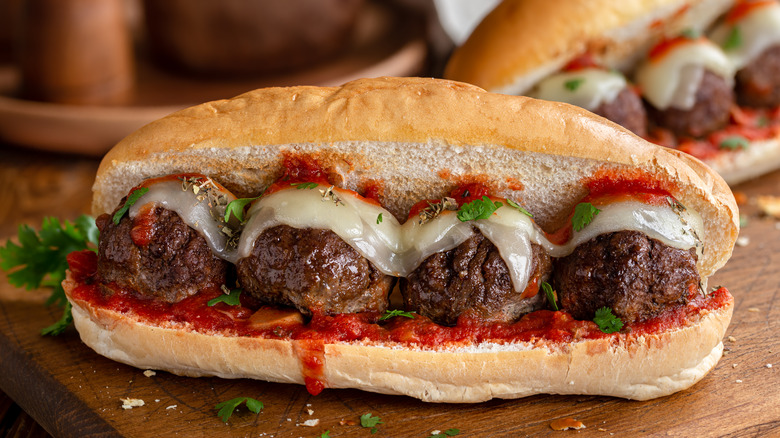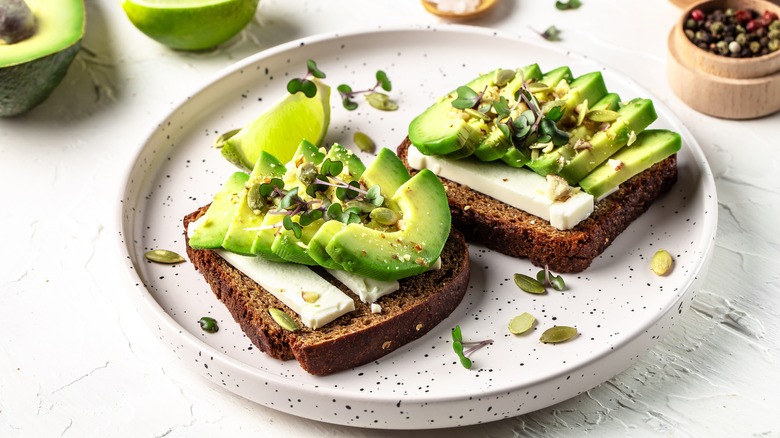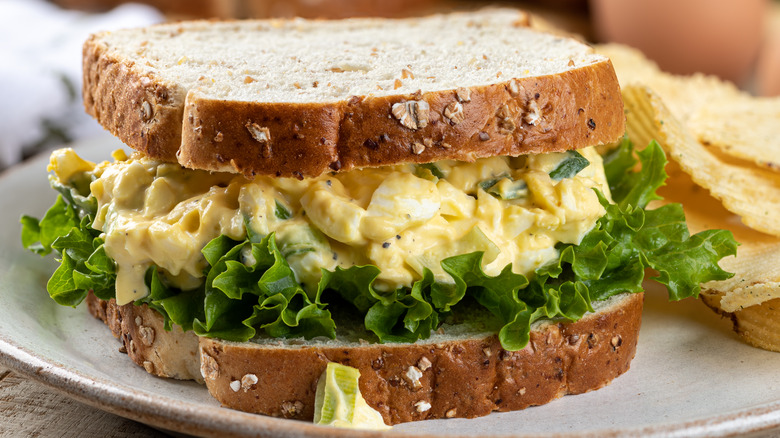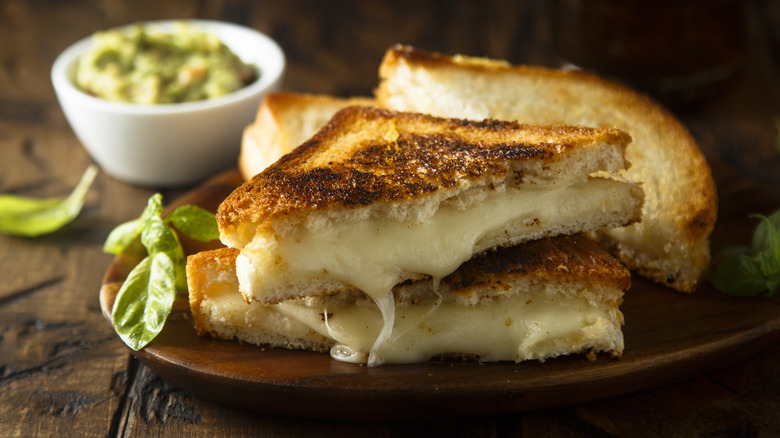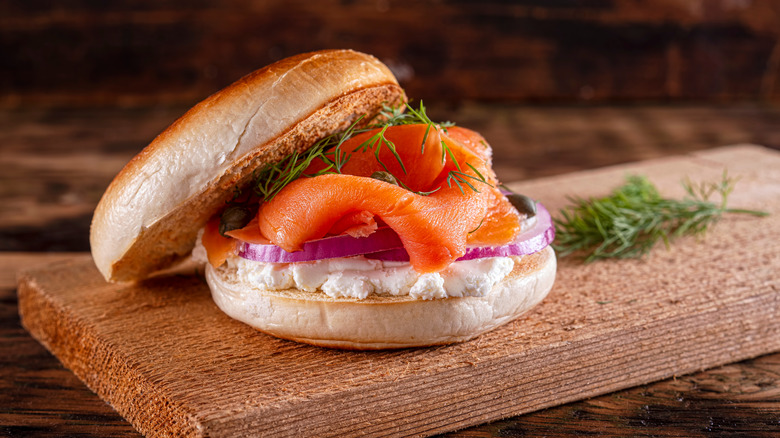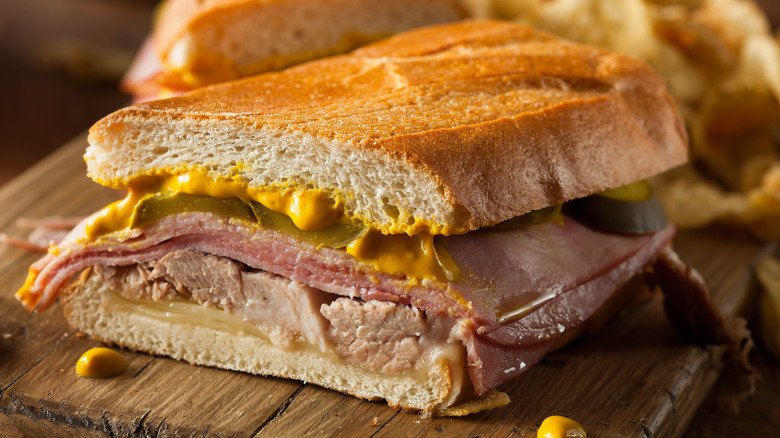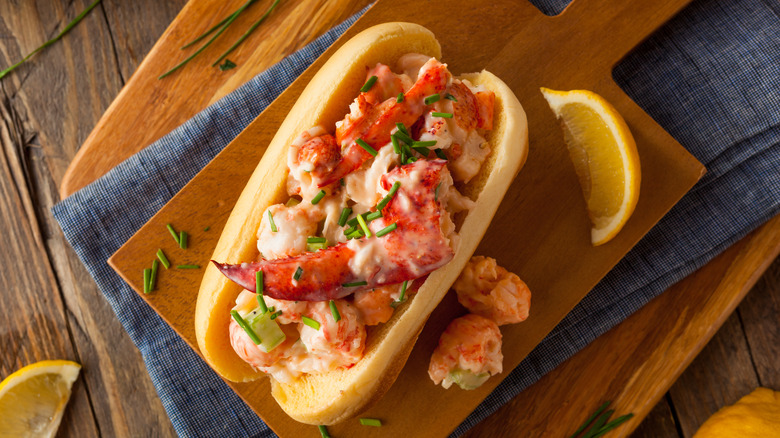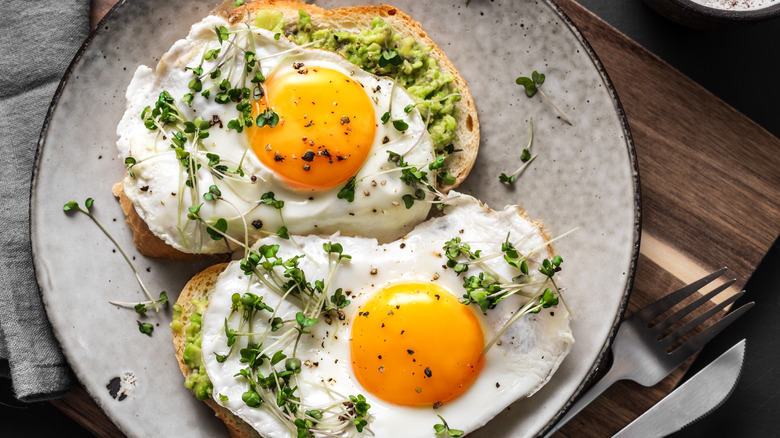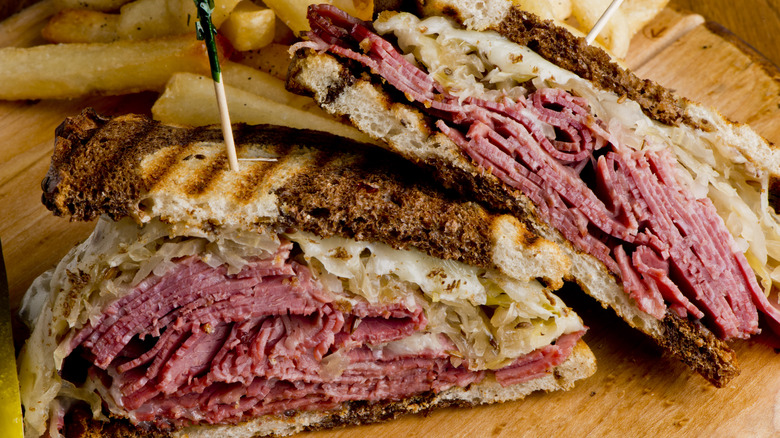6 Best And 6 Worst Sandwiches To Order At A Restaurant
We may receive a commission on purchases made from links.
The sandwich is one of those dishes that everyone loves. The idea of packing a meal inside bread is genius and incredibly convenient, so it's no wonder it conquered the world. Although it is now found in every corner of the globe, it's not clear who was the first to put two pieces of bread together and call it a sandwich. History claims that it was named after the 4th Earl of Sandwich, but the basic idea has been around for thousands of years, though perhaps not in its current form. The options we have today are seemingly endless, and despite earning the image of a quickly assembled homemade meal, sandwiches are also a restaurant staple.
If you're grabbing a sandwich at a restaurant, there are several things you want to avoid. First, you don't want sandwiches that are made in advance or something that has been sitting on the kitchen counter for hours. Go for seasonal ingredients; it might not be the best choice to get a tomato sandwich in the dead of winter. Lastly, think about the value you're getting for the price. What are you paying for? Stick to ham and cheese at home, and at restaurants, opt for sandwiches that require hard-to-get ingredients or elements that are too time-consuming to make at home. This round-up includes the best and the worst restaurant sandwiches, but there are many in-between options, so use your common sense and never have a bad sandwich again.
Worst: BLT
The BLT is one of the greatest sandwiches of all time. The combination of crisp bacon, juicy tomatoes, and fresh lettuce tucked inside bread slices sounds like a perfect blend of savory ingredients, but when you order BLT at a restaurant, you usually end up with a big heap of disappointment. What makes this sandwich special is the simplicity of ingredients — there are usually no fancy additions in the BLT — but the star trio has to be of exceptional quality, and the sandwich has to be freshly made and assembled to order. In restaurants, this is rarely the case. The bacon is usually pre-cooked and left on the counter for too long, so it turns into a wobbly, chewy strip with no signs of crispiness, while the lettuce lost all its vigor the moment it was cleaned. The tomatoes might be the biggest issue. As we all know, tomatoes are a seasonal summer product, and for most of the year, the tomato slices inside a BLT are bland, flavorless, and dull. A BLT can also be a questionable order due to its cost, as the amount of ingredients often does not justify its price.
If a BLT is your absolute favorite to eat at restaurants, check out the list of U.S. restaurants with the best BLTs, and follow the advice that Michele Anna Jordan — the author of "The BLT Cookbook" — shared with Today: Avoid it when tomatoes are not in season.
Worst: Tuna sandwich
Although a tuna sandwich might sound like a healthy choice, don't be fooled by the name and the supposed health benefits. A tuna sandwich is usually a simple combination consisting of two slices of bread and a filling that combines shredded pieces of tuna with mayonnaise, mustard, and sometimes onions. You should avoid this sandwich option at restaurants mainly because of the texture and sogginess. Even if appropriately drained, the combination of tuna and mayo can be somewhat runny. It often makes the bread, especially classic toast, wet and moist, two adjectives you never want to associate with bread.
Although it is often lauded as a protein-packed and nutritively rich food, not everything about tuna carries positive connotations. As Britannica explains, tuna is one of the favorite seafood in the U.S. and one of the most popular seafood options worldwide. Naturally, such high demand has a negative influence on the fish stock and the sustainability of the tuna population.
Also, you can't even be sure there is tuna in your sandwich. As NPR reported, the recent controversy with Subway tuna sandwiches proves that the label and the name can be deceiving, and despite regulations and inspections, you really can't be sure what is inside the tuna mix, so it's best to avoid the tuna sandwich order at restaurants.
Worst: Meatball sandwich
The meatball sandwich is next on the list of sandwiches that should be avoided at restaurants. Typically, this sandwich will consist of a bread roll packed with meatballs covered in a generous amount of tomato sauce. The combination sounds reasonable and even tempting to try, but you should think twice before making the order. The meatballs are often reheated, so you can't be sure how old they are, especially if the place doesn't specialize in meatball subs. Additionally, it seems that Subway's meatball sub is not popular among the employees and can be a painstaking order to assemble.
Meatball sandwiches are also awfully messy to eat. As one Reddit user explains, meatball subs are simply inconvenient. The meatballs break easily, and the accompanying sauce they come doused in will most likely leak, making the bread soft, soggy, and unable to hold the structure. Eventually, expect to find pieces of meatballs and heaps of sauce everywhere.
Worst: Avocado toast
Avocado toast might enjoy a lot of love these days, but it's questionable how much popularity it deserves. According to Brit+Co, avo toast has long been a staple on bistro menus, well before it became Instagram's favorite. The trend allegedly started with Bill Granger, who first put it on the menu in 1993 at his Sydney-based restaurant. In the United States, this brunch favorite became a staple in the late aughts. Avocado toast is often lauded as a healthy sandwich alternative, primarily due to avocado's multiple health benefits — Harvard University claims it's packed with minerals, good fat, and fiber — but avocados fall flat on the sustainability test.
As explained by The Guardian, more chefs are trying to replace avocados with more sustainable options. Avocados are still primarily grown in Central and South America, and according to Thomasina Miers, a chef and a restaurant owner, the increase in global consumption makes avocados less affordable for the people living in avocado-growing areas. Sustainable Food Trust writes that when compared to other fruit groups, avocados have a relatively high carbon dioxide footprint. As they usually travel long distances, they require energy-straining storage and travel conditions.
If you still want to indulge in avo toast, you are certainly better off making it at home. The dish requires literally no particular cooking skill, so anyone can easily and quickly whip it up at home and save money for more elaborate restaurant options.
Worst: Egg salad sandwich
Egg salad can be a nutritious, quick, and easy homemade dish, but as a restaurant option, especially tucked inside two pieces of toast, it simply doesn't work well. According to The Nibble, the egg salad was created in the early 1800s and was probably first made into a sandwich in Great Britain. Since its conception, it has always represented an inexpensive, protein-packed option, but to be a successful dish, it must be made fresh. Nothing is more unappetizing than a mix of chopped boiled eggs and mayo that has been sitting on the counter for too long. Though Food Safety says you can keep your egg salad in the fridge for up to four days, we don't recommend this as the liquid will start to separate, the eggs will become soggy, and there is a good chance that the salad will lose its flavor.
In a restaurant setting, you may receive pre-made egg salad, which is sometimes even smeared on the bread well before serving. As it has a somewhat wet consistency, the egg salad will quickly turn the bread into a damp mess that will immediately break apart and generally provide a rather unpleasant textural experience. Stick to homemade egg salad sandwiches because you can be sure of the origin and quality of ingredients and the freshness of the egg spread.
Worst: Grilled cheese
You might think that a grilled cheese sandwich doesn't belong on the list of worst sandwich orders at restaurants but hear us out. Grilled cheese is an American classic — nothing beats the combo of melted cheese and perfectly crisp toast, but it is one of the sandwiches you should make at home. Restaurants frequently use poor ingredients, and as they are perpetually busy, their grilled cheeses often get off the grill a bit too soon, resulting in an underwhelming experience and a less-than-average sandwich. At home, you can leave the bread to toast until you get that perfectly crisp crust and wait just enough for the cheese to turn into a melted cheese delight. The best thing about a homemade version is that you can enjoy it immediately while it's still warm and gooey.
Before you start thinking that there are far superior grilled cheese variations that use expensive and gourmet ingredients, the rudimentary toast/American cheese combination might be the best. Insider conducted a very interesting taste test by comparing a classic grilled cheese sandwich, approximately priced at $6, with a gourmet version that would cost $42. The result? According to the author, the cheaper version proved superior. Classic is something you don't want to mess with, so don't get fooled by the epicurean grilled cheese, as it's simply not worth it, and replace the standard grilled cheese order with something that you can't easily make at home.
Best: Bagel and lox
A Bagel and lox is one of the best sandwich options you can have at a restaurant. This sandwich that combines a bagel, cream cheese, and cured salmon is almost synonymous with New York, but none of its ingredients actually originate from New York. As journalist Heather Smith told NPR, lox (cured salmon) has its origins in Scandinavian culture, though Native Americans also used similar fish curing and smoking techniques. The cream cheese is considered native to Britain, while the bagel could be regarded as New York original, but it was inspired by similarly shaped European and Asian loaves. The combination of this glorious trio, according to Smith, most certainly originated in New York.
Many restaurants serving bagels and lox specialize in bagels or deli specials, or sometimes both, so you will most likely get top-notch ingredients in this sandwich. It is also one of the most popular orders at delis, so you will probably get your order freshly made. It's worth pointing out that cured salmon is preserved, so there is a less likely chance that it can go bad. A bagel with lox is convenient to eat at a restaurant, and as we all should eat more salmon, it is also a nutritionally balanced sandwich.
Best: Cuban sandwich
The Cuban sandwich might be a less familiar item on the list, but this only means that you should be ordering it more. Despite its name, it's not entirely clear where the Cuban sandwich originated. As El Meson de Pepe explains, there are different accounts of its origin, but it most likely first appeared somewhere in Florida and was certainly inspired by Cuban tradition. A classic Cuban consists of sliced Cuban bread that is filled with mojo-marinated pork, ham, cheese, pickles, and mustard. The sandwich is pressed, which heats the bread and allows the fillings to remain neatly nestled between the two slices of bread.
The Cuban sandwich is a great restaurant option as it is compact and convenient, not to mention utterly delicious. All the ingredients inside perfectly complement each other, and along with lightly pressed bread, make a feast for the palate. The components that go inside the Cuban are standard, and it's difficult to go wrong with this order. As a bonus, you won't find sad, soggy veggies inside the Cuban sandwich.
For the best Cuban sandwiches, go through our list of the best Cuban sandwiches in the U.S. and find the one closest to you.
Best: Lobster roll
Let's be honest: A lobster roll is something you will rarely make at home. Even if you get your hands on a nice, fresh lobster, the time-consuming preparation and the total cost of the experience are simply not worth it. However, ordering a freshly assembled lobster roll at a coastal seafood place will certainly pay off. According to Lobster Everywhere, lobster rolls originated on the East Coast and are mainly associated with New England. First made by local fishermen, the sandwich has now become a regional specialty, and no one should miss the chance to devour at least one of those butter-smeared rolls packed with a hefty amount of freshly cooked lobster.
The lobster roll is certainly one of the best sandwiches you can order in a restaurant, but be aware of where you're eating it. The best restaurants will specialize in lobster rolls, meaning they constantly whip out orders so you get the freshest possible dish. Also, it's one of the recipes where you can't hide the main ingredient. Lobster is the shining star of the dish, and it's not covered up with many other components, so any reputable restaurant will have to get the best-quality catch. For the best lobster rolls in the U.S., make sure to check our list to find which restaurants make the best versions.
Best: Fried egg sandwich
While the egg salad sandwich might've earned its place as one of the less desired restaurant orders, the fried egg sandwich is one of the best options. It can be made as an open-faced or closed sandwich, and the best thing about it is that it is incredibly versatile, so you can easily adapt it by adding or removing ingredients. The neutral flavor of fried eggs nicely pairs with various cold cuts, veggies, and condiments. Also, remember that eggs are packed with proteins, nutrients, and good fat, making them one of the healthiest sandwich ingredients (via BBC).
Along with the nutritional aspect, if you order a fried egg sandwich, you can be sure that the sandwich will always be freshly assembled. Frying eggs is such a quick process that you will very likely be served an egg that's been fried to order. A bonus: you can ask for a runny, soft, or fully cooked egg — and all will be equally delicious.
Best: Reuben
The Reuben is a stellar sandwich. This deli favorite is traditionally made with rye bread stacked with seemingly infinite layers of corned beef topped with sauerkraut, Swiss cheese, and Russian dressing. All About Delis describes it as an incredibly filling sandwich whose ingredients result in a perfect blend of complex flavors and textures. Because it is assembled with several components that have to be prepared separately and are not always at hand, it is one of the best sandwiches to eat at restaurants.
Despite its Irish origin, in the U.S., corned beef was popularized by Jewish delis, and their brisket corned beef is traditionally used for the Reuben — which also stems from the Jewish-American culinary tradition. As explained by the Smithsonian, Jewish butchers and chefs used kosher brisket to make corned beef, and as it is a tough and lean cut, it requires long cooking to become the tender piece of meat that we can then stack inside a Reuben. Because of this, a Reuben will probably not be your quick and easy homemade snack. Instead, leave the preparation to those who do it best and have a Reuben at your favorite deli.
Best: Croque madame
The best sandwich to have at a restaurant is the one that requires long cooking or the one that is always prepared fresh, and a croque madame checks both boxes. Croque madame originated in France and was inspired by croque monsieur, a simple combination of cheese and ham tucked between two slices of bread that is then grilled until crisp. The madame version went a step up and added a fried egg on top. Along with the egg, a common addition is a heap of thick bechamel sauce in which the sandwich is doused before it is toasted. Regions of France explains that it is one of the classic bistro sandwiches in France, and because of its hearty and comforting character, it's one of the best wintertime meals.
A croque madame sounds like something you are better off eating at a restaurant. Due to different elements — frying the egg, grilling the sandwich, and whisking up bechamel — it sounds like a painstaking, time-consuming homemade option, and it is simply better to have it made by a professional.
